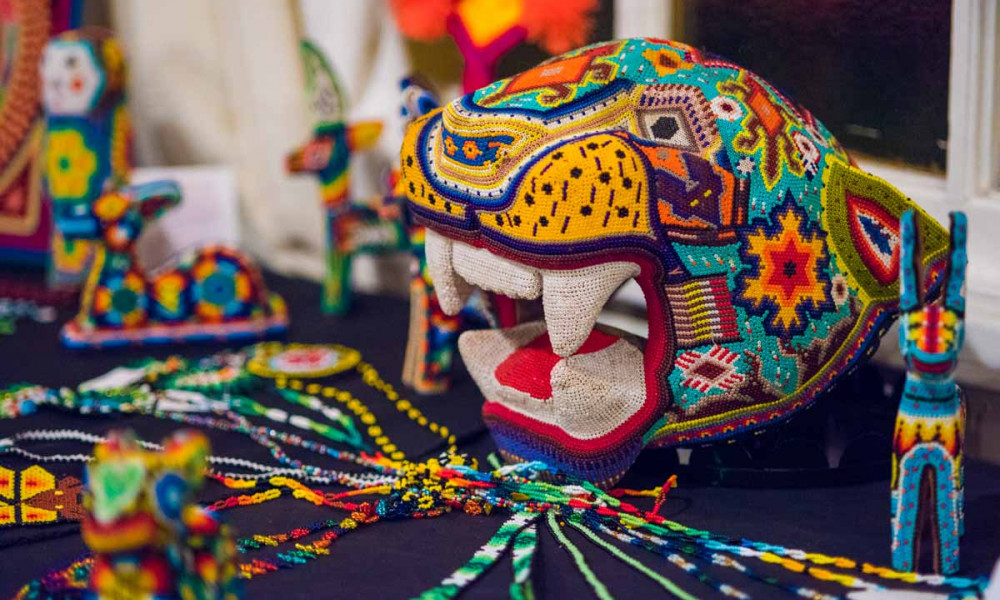Step over threshold: The magical art of the huichol

Twilight land of legends always have a shelter for a weary traveller: no one is alone on the paths of spirits.
Works by Huichol artists noticeably stand out against the abundance of souvenir production, filling stalls of Mexican markets at the height of tourist season. Juicy psychedelic tones break beyond the accurate lines of patterns strictly calibrated by tradition, blurring boundaries between dream and reality. The distinctive art and crafts of Huichol people do not follow requirements of modern satiated audience, remembering about its sacred mission to transfer messages of the subtle world. Photo 3.bp.blogspot.com
Photo 3.bp.blogspot.com
Each Indian artist also acts as a shaman, transferring to a mosaic his visions seen in an altered state of consciousness. To dive into a trance, village sorcerers use the peyote cactus juice containing psychoactive substances. Disinhibition of subcortical structures of the primitive psyche opened up access to the direct perception of reality outside the individuality, space and time imposed by brain and socialization mechanisms. Finished products that are brought as a gift to the spirits-helpers, were used to decorate sanctuaries and huts. Keeping in contact with the transcendent experience, the Indians cultivated a sense of unity and harmony with the creative forces of the Cosmos. Invisible threads connecting everything into a single body, are depicted in the form of zigzag lines connecting diverse figures on the canvas.
The artistic tradition of the Huichol supports two related areas: nierika and chaguira. Creating nierika, craftsman shows miracles of patience while filling in surreal pictorial panel of dyed wool. The basis is a wooden tablet with a hole in the middle through which people and gods can see each other. A smooth surface of sanded and waxed wood is covered with a thin layer of beeswax into which threads of multicolour woollen yarn are pressed. A resulting complex fantasy picture has something in common with the Buddhist mandala. Iridescent play of colours radiates a powerful energy of primordial elements that feed the national ideal of invincible vitality and resilience in the face of trials. Photo img-fotki.yandex.ru
Photo img-fotki.yandex.ru
Chaguira genre involves decorating of masks, vessels and figurines with intricate mosaic ornaments. The waxed work pieces carved from wood and pumpkin are covered with beads and pendants. Some artisans prefer improvised material: seeds, grains, small pieces of stones and mineral crumbs.
See also: Art of topiary
According to some anthropologists, Huichol mythology most reliably reflects perception of environment of the Aztecs. Missionaries were in no hurry to carry the Good News to remote villages, lost among the harsh peaks of the Sierra Madre. The geographic isolation of indigenous communities safeguarded original system of occult symbols from the Christian impact, compensating the scarcity of available tools for visualization of vast metaphysical landscape. Every detail is imbued with secret meaning, and the selected colours and materials translate certain energies. Here it is not just a fun souvenir, but a real magical artefact! Photo volshebnaya-strana.com.ua
Photo volshebnaya-strana.com.ua
It is not difficult to guess the meaning of cool blue and green tones in the colourful palette of magic - cool breath of the long-awaited rain ripples down the palms. Brownish-red shades and wood belong to the god of fire Tatewari. Skull, frozen in a happy grin, promises to meet with the goddess Coatlicue, ruling over death and birth. Father Sun more willingly responds to requests, inscribed on the tablets made from the Brazil tree, which are delivered to him by his faithful companions - the royal eagles and macaws. Pine tree, a coyote, and a whirlwind, sooner or later, attract the mischievous god deer Kauyumari - the ancestor of all the Huichol. The thickets of banyan hide the ancestor of gods Nacawé surrounded by bears and armadillos. From village to village, wander stories about ritual hunting in reserve of Virikuta and about creation of the universe in a love embrace of the Sun and the Moon. Some images preserve echoes of more ancient times: for instance, the cult of the goddess butterfly Itzpapalotl is a legacy of the Aztecs, and jaguars are borrowed from the Mayas. Photo i.ytimg.com
Photo i.ytimg.com
Puzzling composition of nierika and chaguira deliberately gives an outsider the run around, showing hundreds of masks of the same archetype, although the concept of product almost always comes down to the alchemical cycle of holy trinity of corn cob, deer and peyote. Indians’ logic is clear: corn is the material basis of life, peyote symbolizes a spiritual reality, and deer has a right of the god creator and the ability to move between worlds, linking the opposites together. The tension between two poles creates life. Photo permaculturesayulita.com
Photo permaculturesayulita.com
Leading Mexican designers often turn to folk motives in search of the unique decoration ideas. Donna Emeterio Rios Martinez creates magnificent murals of yarn, make up for the lack of heart warmth in the urban area. A Huichol bead mural decorates a hall of metro station Palais Royal-Musee de Louvre in Paris: it is a huge canvas-nierika Huichol Thought and Soul mounted from eighty panels - a gift from colleagues from Mexico City Metro. Perhaps, the most unusual work done in the Huichol folk style is an art object Vochol - a car Volkswagen Beetle, braided by fabulous flowers from beads, fastened to the body of the car using a special heat-resistant resin. Photo skullsproject.files.wordpress.com
Photo skullsproject.files.wordpress.com
Cover photo shamanism.com





















